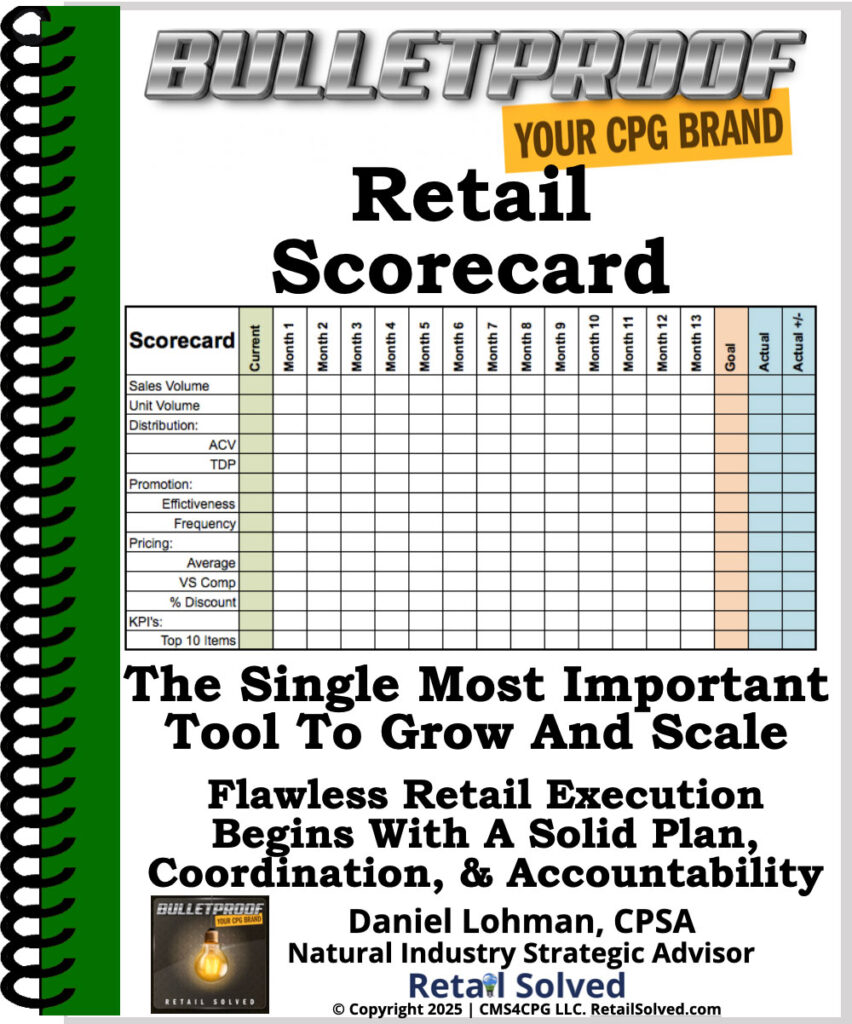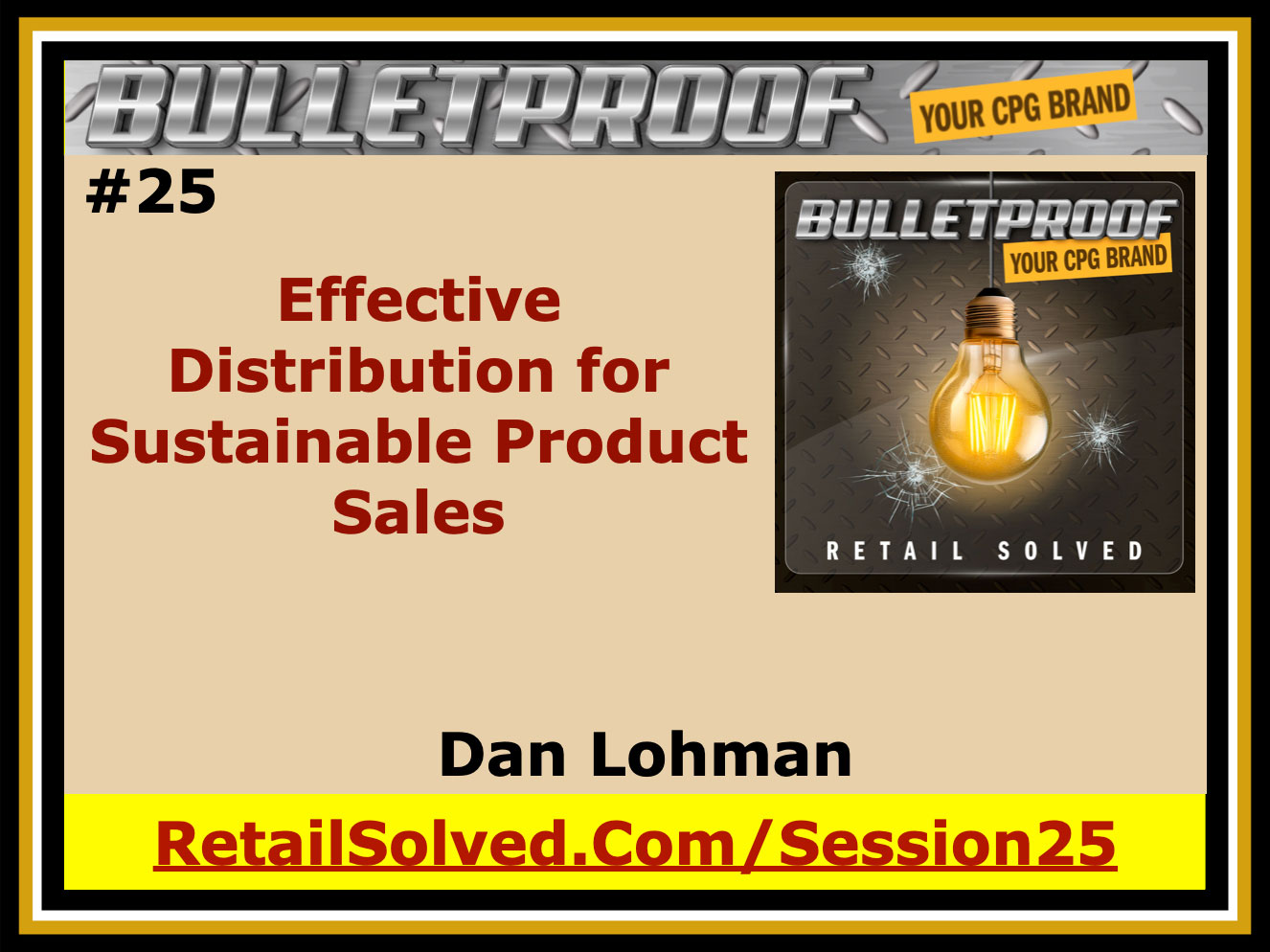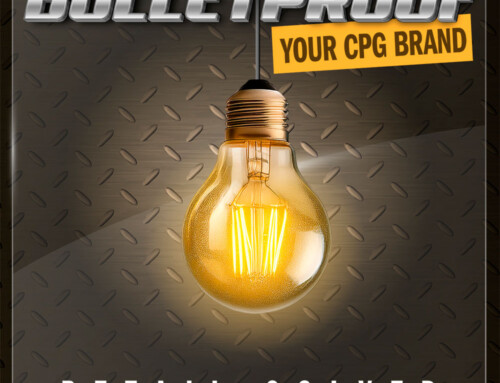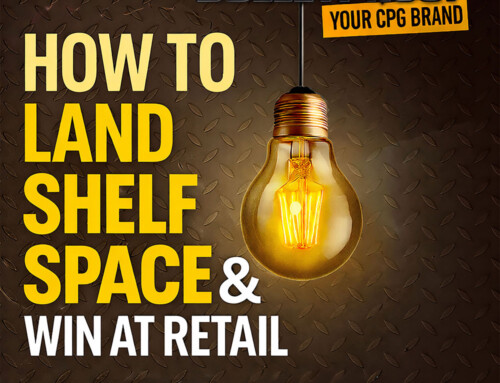Unlock the potential of effective distribution to boost your sales Learn how to ensure your products reach more consumers. Distribution is crucial for all brands, especially smaller ones, as it impacts sales and customer satisfaction. Prioritizing top-selling items in every store and strategically placing other flavors in larger sections helps build a strong brand foundation and defend against competition.
The cornerstone of every brand's success is happy customers. Ensure that your products can be found where they shop. Nothing happens until someone buys your product & shoppers can't buy what they can't find. Learn to grow sales by increasing distribution
Today I want to talk to you about distribution. This show is for anyone who wants to get more sales out of their dollars.
Listen where you get your podcast
Important: Brand Secrets and Strategies has been rebranded to Retail Solved. Please swap all BrandSecretsandStrategies.com URL’s with RetailSolved.com. This is now the Bulletproof Your Brand podcast. Thank you for listening! BRAND SECRETS AND STRATEGIES PODCAST #25 Hello and thank you for joining us today. This is the Brand Secrets and Strategies Podcast #25 Welcome to the Brand Secrets and Strategies podcast where the focus is on empowering brands and raising the bar. I’m your host Dan Lohman. This weekly show is dedicated to getting your brand on the shelf and keeping it there. Get ready to learn actionable insights and strategic solutions to grow your brand and save you valuable time and money. LETS ROLL UP OUR SLEEVES AND GET STARTED! Hello, today I want to talk to you about distribution. It doesn't sound like a very exciting or sexy topic, but trust me, this is one of the most important things you need to do. Distribution impacts every brand on the shelf. This show is for anyone who wants to get more sales out of their dollars. First I'd like to share a little background. I think this will resonate with you. Distribution is the one thing every brand struggles with, regardless of their size. The difference is that the big brands don't feel the impact as much as the small brands do. When I say small brands, I'm talking about $100 million or less. That sounds like a pretty high number, but let's be honest, the bigger the brand you are, the less that you feel the impact of this. Let's continue. You've probably heard me say this several times. Nothing happens until someone buys your product and shoppers can't buy what they can't find. The path to sustainable sales is getting your product into the hands of more shoppers and is critical to increasing sustainable food production and sales. So what does this mean and how does it impact you? If a consumer goes into a store to buy your product and they can't find it, they might buy your competitors product. On shows like Shark Tank, you often hear people talk about the cost of acquisition. The cost of acquiring and retaining a new customer is extremely expensive. It's even more expensive to try to reacquire that customer after you've disappointed them. Say for example, not having the product on the shelf, or your customer was unable to find your product. That's why this is so critical. So let me talk a little bit about my experience. I too had trouble understanding this. Now as a retail grocery manager, I understood that not having a product on the shelf meant lost sales. I also understood that it meant disappointed customers. I spend a lot of my time trying to understand how consumers buy and how consumers shop. Merchandising sections differently and making them more shopper-friendly is key. The easier it is for a consumer to find your product, the easier it is for them to buy it and purchase it. Makes perfect sense, right? This had a lot to do with my success as a DSD driver. I sold salty snacks many different retailers in Colorado. I learned quickly that the bigger the display, the better the merchandising, the more product I could sell. What I didn't fully understand, and this is why this is important, is that there is a huge difference between selling an impulse item, and selling something else like toilet paper, or milk. When you sell impulse items, it's a very different consumer experience. If they go into buy one bag of chips, and they see a special sale, or a special deal, customers will frequently pick up two, or maybe even three bags. It's an easy purchase. By leveraging my background as a former grocery manager, I was able to quickly become the top sales person in the region. But then when I switched over and started working for a retailer manufacturer, I had to rethink the importance of distribution. I went from selling an impulse item, to selling an item that was more of a staple. Let's face it, consumers can only drink so much milk. They can only use so much toilet paper and soap. It doesn't matter how much you promote, or how well you promote toilet paper. Consumers aren't going to consume any more of it. This is why this show matters. This is why this is so important. You need to understand the power of distribution, so, let me go a little further. I quickly learned that not having an item in distribution at a store, made it harder for me to promote the item, and for me to drive sales toward that retailer, toward that category. As a result, it made it harder for me to meet my numbers overall. I also realized that not having distribution in store, meant giving my competitor an advantage over me. It meant weakening my brand, or the foundation of my brand, to be able to grow sales, etc. Another lesson I learned, and you'll find this interesting too, is that consumers change the way that they consume products based upon what's in the house. Now obviously, this doesn't apply to toilet paper. As an example, if you have a gallon of milk in the refrigerator, you're going to be free to drink as much as you want or put it in your coffee. However, when you get down to the last cup, you're going to try to conserve. You don't want to use up all the milk, you want to save it for someone else down the road, or perhaps at the end of the cereal box, there's a little bit left over. My point is this, while distribution is important, it's also really important to consider the way the consumer uses your product. You want to make sure that they have enough product on hand, so that it's there for them when they want it. This is the part of the key to your strategy. You've got to plan ahead, to make sure that the consumer doesn't have an opportunity to buy your competitors product when they run out of yours. You want to make sure there's enough in their home to satisfy their needs. Again, I find this problem with literally every brand I work with. No matter what size, big brands, mainstream brands, small brands or retailers, all have this problem as well. So let me give you a better example of how this works. Let's say that you sell energy bars. You have 11 items. You go to a 100 store chain. Over the 100 stores, you manage to get every item in distribution. Let me clarify that, you have all of your items in distribution throughout the entire chain, but no one store has every single item in it. Let's say every store only has four or five items total. And you think, "Wow, this is great - we're doing really well." But are you really? Here's why this is an issue. Let's say that the top selling items, the top selling flavors in the market are chocolate, peanut butter, and coconut. And let's say that 20% of the stores within the chain are selling your raspberry item. Well there's no way that raspberry's going to compete against the top selling items, especially if it's only in distribution in 20 stores. So, when the retailer starts looking for slow moving items, your raspberry item is ranked lower on the list, on the total chain. This puts it at serious risk of being discontinued. Or even worse, your competitor has been listening to this podcast. They understand these strategies, and how to use them. So your competitor goes into the retailer and says, "I've got a new item, and I want you to put it in distribution. Oh, and here are the low hanging fruit". They want to get rid of your brand. Well, this is how you defend against that. This is one of the key reasons why I continue to say that you have to know your numbers. So, let's say that you know that your chocolate, your coconut, and your peanut butter are your top selling items, and they do very well in the market as a whole, and everywhere they're sold. So, if you don't have those three items in every single set, then that's a huge mistake. Those three items are going to help you develop the foundation to build healthy sales earned, to be able to promote, etc. I'll get to that more in a minute. The other flavors that you have, for example the raspberry, is included in the stores with a larger set, with a larger section to be able to sell energy snacks. Let me be very clear, if a store only has a four foot set, and you're able to get raspberry in, that's fine. But make sure, absolutely sure, that you first have your top three selling items in every store. No excuses, no if, ands, or buts. Those three items are going to be the core foundation to grow your business on. If their store has a large enough section to accommodate raspberry, and blueberry, and some of the other brands, some of the other flavors that you have, well that's great. That's additional distribution. That's how you grow your brand overall. However, if you allow a flavor like raspberry in this example, to take the place of chocolate, then you dilute your brand, you weaken your position on the shelf, and you weaken the foundation to grow your brand. So, how do you know how to do this? How do you know what strategies to use? Have you ever heard of a KPI, a Key Performance Indicator? KPI's are micro strategies. They're the strategies that you put in place that signal your marching orders to your entire team, to your broker, to your internal and external sales force. KPI's contain the marching orders of how to get what items in distribution. What your price point should be, where the items should be merchandised on the shelf, what flavors should be merchandised or added into distribution in order, one, two, three, four of importance. I recommend that you have several KPI's. If you have a store set, for an example that we're using now, a store with a four foot set. Let's say that's the smallest in the market. What three or four items do you want to have in distribution at every single store? Again, no excuses, no exceptions, period. These are the four items you're going to sell, and once those are sold in, you can sell something else. The next size in their market is a six foot schematic. Let's say in that store you have your top three items, plus two more, raspberry and blueberry. The next largest schematic is going to be eight foot. Let's say in that section we're going to add banana, and cashew, and so on. Keeping in mind that in every single store you've got chocolate, peanut butter, and coconut. That's again, the foundation you want to build on. The other flavors simply enhance, or add to your assortment. Your other flavors are based upon what's selling in the market, based upon what consumers want. By the way, when you're thinking about what's selling in the market, don't just focus on your brand. Focus on the flavors of your competition. What are people buying, what are their favorite flavors? Not only does this help you build your brand, but it helps you communicate to the retailer that you understand your customer, that you understand how your customer, and other customers in the category shop their store. Again, this is what retailers really want and need. Help them. Demonstrate to them that you're a leader in the category, and that they can look to you for these types of insights. So now let's bring this home. Distribution equals a strong foundation to build on. It provides you an opportunity to grow sales. It gives you an opportunity to more effectively and more efficiently ship to the store. In this example, let's say that you don't have a lot of sales in some of the smaller stores, and so you might have a mixed case. Well having a mixed case with your top three selling items is going to be a lot easier to sell in, than having a mixed case of maybe your top two selling items, and something that's ranked number 11 in your item assortment. This is also going to give you an opportunity to more effectively promote your product. Most brands promote everything within the same type of product, all your energy bars together. That makes good sense. But, if you're promoting your top one and two item with your number 11 item, you know you're not going to get the same sales bump that you would get if you promoted one, two, three, and maybe number five on your ranking. Remember, the purpose of a promotion is for customer acquisition, and to drive traffic toward that category. You want to put your best foot forward. You don't want to spend a lot of money promoting items that aren't going to sell. So why not have your top three items available in every store, promote this, in addition to your other items? Next, this strategy opens you up for new item distribution. What I mean by that, is that once you've got a firm foothold on a shelf, or within a retailer, it's easier for the retailer to understand that you're serious about driving sales in their store. It's easier for the retailer to appreciate, and value you as a brand, as a manufacturer. So they're going to be more willing to try new products in different categories, or maybe even the same category. It's a lot easier to gain distribution, even new distribution, in a retailer that you already have distribution in. It's easier still if you can prove to the retailer that you're going to support your items on the shelf, and that you have a winning formula to help them drive sales in their category. Remember, that's what retailers want. They want your help, and helping them compete more effectively in their market. Next, this gives consumers what they want. If a consumer goes into a store and can't find your item, they're going to be disappointed again. They might buy a different item. But if they go into a store and they find your top three items at every single store they go to, that makes it easier for them to shop. Let's face it, consumers go to a variety of different stores. It's rare to find one shopper that's dedicated and only goes to one retailer. So again, having distribution, the same distribution in every store makes it easier for consumers to shop your brand. It makes it easier for consumers to trust that you're items are going to be there, on every retailer's shelf, no matter where they shop at. This also helps you with your sales story. If you can go to a retailer and you can say, "Well my brand is selling in every store in the market, including your competitor", this increases your chance of that retailer agreeing to put your item on their shelf. Especially if it's doing well in the market, and at their competition. I know we've covered a lot in a short time. I'll be talking more about this in other episodes and in my spring courses. But for now, I hope I've given you a good synopsis of how and why this is so important. When you think about the basics and the things you have to do to be successful, this is one of the most important things to remember. The absence of distribution means that you don't have a product on the shelf. It means that you can't compete effectively in the market. It means that you dilute your brand, and that you're not putting your best foot forward. Remember, that every opportunity that you have to get your brand, or your product in front of a consumer is a selling opportunity. If you waste that, it's going to cost you more, and it's going to be a lot harder for you to develop that relationship with your consumer. I hope you found this episode helpful. I have a lot of great content planned for this year, including more interviews with industry thought leaders in addition to launching my ground-breaking courses this spring. As always, I'd love to hear your thoughts and to know what's important to you. What topics do you want me to cover? What do you want me to share with you? What thought leaders do you want me to interview? Please send me an email, and let me know what you'd like to learn from this show and my courses. Today's freebie is my Retail Scorecard. Use it to put your KPI's on, share it with your sales team, internally and externally. Let them know what are the top items that they need to have in distribution at every store. What is your promotional plan? Include what your strategy is to help each retailer grow sales in their market. You can download the Retail Scorecard by texting, "Retail Scorecard," to “44222” to get it instantly. Or, you can download it and get it in the show notes at BrandSecretsandStrategies.com/Session25. I look forward to seeing you in the next show This episode's FREE downloadable guide Scorecards are powerful goal setting tools. You’ve probably heard that “what gets measured gets done”. Scorecards map out objectives in bite-size manageable chunks that keep you on-track and focused. They're what you need to succeed. CLICK HERE TO DOWNLOAD YOUR FREE STRATEGIC GUIDE: Retail Scorecard Thanks again for joining us today. Make sure to stop over at brandsecretsandstrategies.com for the show notes along with more great brand building articles and resources. Please subscribe to the podcast, leave a review, and recommend it to your friends and colleagues. Sign up today on my website so you don’t miss out on my new courses and more actionable insights and strategic solutions to grow your brand and save you valuable time and money. I appreciate all the positive feedback. Keep your suggestions coming. Until next time, this is Dan Lohman with Brand Secrets and Strategies where the focus is on empowering brands and raising the bar.
Enter your name and email address below and I'll send you periodic brand building advice, tips and strategies.
Sign up to receive email updates
FREE Trade Promotion ROI Calculator:
Click Here To Maximize Sales And Profits

Retail Scorecard – Maximize Retail Execution
Want The Most Effective Tool To Maximize Retail Execution?
Exploit your competitions weaknesses by committing to this simple strategy that they overlook. Scorecards are the most powerful and underutilized project management and goal-setting tools that help brands achieve success by breaking down objectives into manageable chunks. Learn how to unlock their awesome power to gain a significant unfair competitive advantage. They’re what you need to succeed!
Image is the property of CMS4CPG LLC, distribution or reproduction is expressively prohibited.











